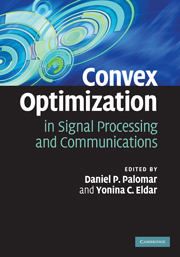Book contents
- Frontmatter
- Contents
- List of contributors
- Preface
- 1 Automatic code generation for real-time convex optimization
- 2 Gradient-based algorithms with applications to signal-recovery problems
- 3 Graphical models of autoregressive processes
- 4 SDP relaxation of homogeneous quadratic optimization: approximation bounds and applications
- 5 Probabilistic analysis of semidefinite relaxation detectors for multiple-input, multiple-output systems
- 6 Semidefinite programming, matrix decomposition, and radar code design
- 7 Convex analysis for non-negative blind source separation with application in imaging
- 8 Optimization techniques in modern sampling theory
- 9 Robust broadband adaptive beamforming using convex optimization
- 10 Cooperative distributed multi-agent optimization
- 11 Competitive optimization of cognitive radio MIMO systems via game theory
- 12 Nash equilibria: the variational approach
- Afterword
- Index
10 - Cooperative distributed multi-agent optimization
Published online by Cambridge University Press: 23 February 2011
- Frontmatter
- Contents
- List of contributors
- Preface
- 1 Automatic code generation for real-time convex optimization
- 2 Gradient-based algorithms with applications to signal-recovery problems
- 3 Graphical models of autoregressive processes
- 4 SDP relaxation of homogeneous quadratic optimization: approximation bounds and applications
- 5 Probabilistic analysis of semidefinite relaxation detectors for multiple-input, multiple-output systems
- 6 Semidefinite programming, matrix decomposition, and radar code design
- 7 Convex analysis for non-negative blind source separation with application in imaging
- 8 Optimization techniques in modern sampling theory
- 9 Robust broadband adaptive beamforming using convex optimization
- 10 Cooperative distributed multi-agent optimization
- 11 Competitive optimization of cognitive radio MIMO systems via game theory
- 12 Nash equilibria: the variational approach
- Afterword
- Index
Summary
This chapter presents distributed algorithms for cooperative optimization among multiple agents connected through a network. The goal is to optimize a global-objective function which is a combination of local-objective functions known by the agents only. We focus on two related approaches for the design of distributed algorithms for this problem. The first approach relies on using Lagrangian-decomposition and dual-subgradient methods. We show that this methodology leads to distributed algorithms for optimization problems with special structure. The second approach involves combining consensus algorithms with subgradient methods. In both approaches, our focus is on providing convergence-rate analysis for the generated solutions that highlight the dependence on problem parameters.
Introduction and motivation
There has been much recent interest in distributed control and coordination of networks consisting of multiple agents, where the goal is to collectively optimize a global objective. This is motivated mainly by the emergence of large-scale networks and new networking applications such as mobile ad hoc networks and wireless-sensor networks, characterized by the lack of centralized access to information and time-varying connectivity. Control and optimization algorithms deployed in such networks should be completely distributed, relying only on local observations and information, robust against unexpected changes in topology, such as link or node failures, and scalable in the size of the network.
This chapter studies the problem of distributed optimization and control of multiagent networked systems. More formally, we consider a multiagent network model, where m agents exchange information over a connected network.
- Type
- Chapter
- Information
- Convex Optimization in Signal Processing and Communications , pp. 340 - 386Publisher: Cambridge University PressPrint publication year: 2009
- 52
- Cited by

